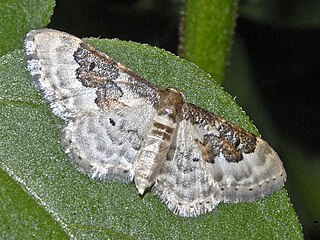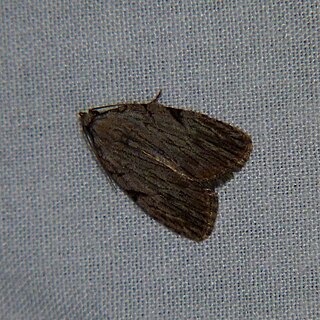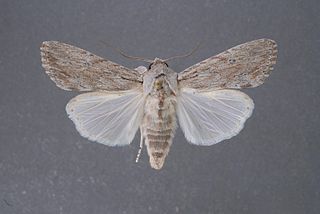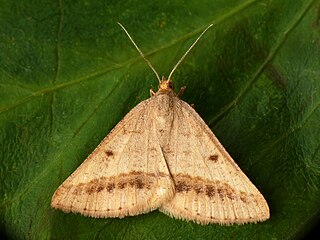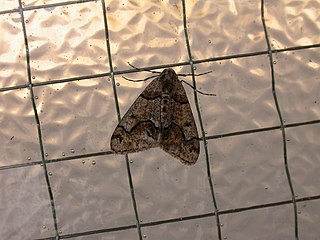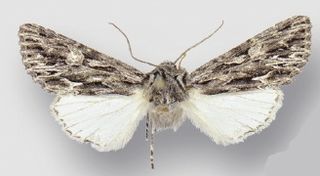| Anavitrinella pampinaria | |
|---|---|
 | |
| Scientific classification | |
| Kingdom: | Animalia |
| Clade: | Euarthropoda |
| Class: | Insecta |
| Order: | Lepidoptera |
| Family: | Geometridae |
| Genus: | Anavitrinella |
| Species: | A. pampinaria |
| Binomial name | |
| Anavitrinella pampinaria (Guenée, 1857) | |
| Synonyms | |
| |
Anavitrinella pampinaria, the common gray, is a moth of the family Geometridae. It is found in most of North America except the arctic regions, south to Mexico.

Moths comprise a group of insects related to butterflies, belonging to the order Lepidoptera. Most lepidopterans are moths, and there are thought to be approximately 160,000 species of moth, many of which have yet to be described. Most species of moth are nocturnal, but there are also crepuscular and diurnal species.

North America is a continent entirely within the Northern Hemisphere and almost all within the Western Hemisphere; it is also considered by some to be a northern subcontinent of the Americas. It is bordered to the north by the Arctic Ocean, to the east by the Atlantic Ocean, to the west and south by the Pacific Ocean, and to the southeast by South America and the Caribbean Sea.

Mexico, officially the United Mexican States, is a country in the southern portion of North America. It is bordered to the north by the United States; to the south and west by the Pacific Ocean; to the southeast by Guatemala, Belize, and the Caribbean Sea; and to the east by the Gulf of Mexico. Covering almost 2,000,000 square kilometres (770,000 sq mi), the nation is the fifth largest country in the Americas by total area and the 13th largest independent state in the world. With an estimated population of over 120 million people, the country is the eleventh most populous state and the most populous Spanish-speaking state in the world, while being the second most populous nation in Latin America after Brazil. Mexico is a federation comprising 31 states and Mexico City, a special federal entity that is also the capital city and its most populous city. Other metropolises in the state include Guadalajara, Monterrey, Puebla, Toluca, Tijuana and León.
The wingspan is 23–34 mm. The color of the forewing varies from medium gray to light yellowish-gray with heavy dark gray or black mottling. The first abdominal segment forms a pale whitish band, bordered proximally by a black line. This black line extends onto the base of the hindwing and onto the forewing, then curves forward but usually breaks before reaching the costa. The postmedial line is wavy and toothed. The subterminal line is white, scalloped or zigzagged. The hindwing color and pattern is similar to that of the forewing.

The wingspan of a bird or an airplane is the distance from one wingtip to the other wingtip. For example, the Boeing 777-200 has a wingspan of 60.93 metres, and a wandering albatross caught in 1965 had a wingspan of 3.63 metres, the official record for a living bird. The term wingspan, more technically extent, is also used for other winged animals such as pterosaurs, bats, insects, etc., and other fixed-wing aircraft such as ornithopters. In humans, the term wingspan also refers to the arm span, which is distance between the length from one end of an individual's arms to the other when raised parallel to the ground at shoulder height at a 90º angle. Former professional basketball player Manute Bol stands at 7 ft 7 in (2.31 m) and owns one of the largest wingspans at 8 ft 6 in (2.59 m).
Adults are on wing from April to October.
The larvae feed on Malus , Fraxinus , Trifolium , Pyrus , Populus and Salix species. [1] The larvae are light brown and mimic twigs. The head is flat-faced, mottled with tan, white, black and occasionally pink. There are often black spots forming a dark blotch to either side of the triangle.

Malus is a genus of about 30–55 species of small deciduous trees or shrubs in the family Rosaceae, including the domesticated orchard apple – also known as the eating apple, cooking apple, or culinary apple. It is dealt with under Apple. The other species are generally known as crabapples, crab apples, or wild apples.

Fraxinus, English name ash, is a genus of flowering plants in the olive and lilac family, Oleaceae. It contains 45–65 species of usually medium to large trees, mostly deciduous, though a few subtropical species are evergreen. The genus is widespread across much of Europe, Asia, and North America.

Populus is a genus of 25–35 species of deciduous flowering plants in the family Salicaceae, native to most of the Northern Hemisphere. English names variously applied to different species include poplar, aspen, and cottonwood.

